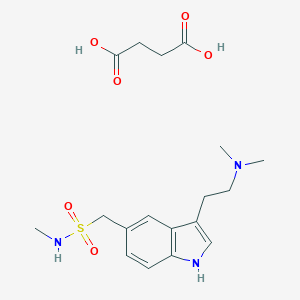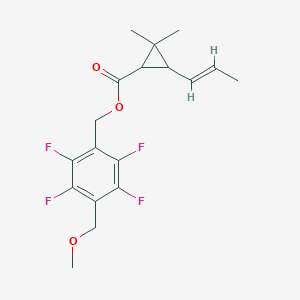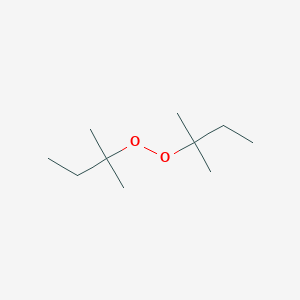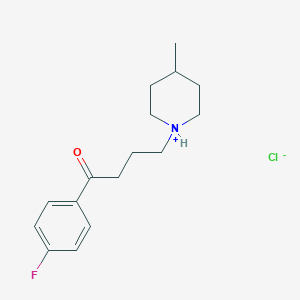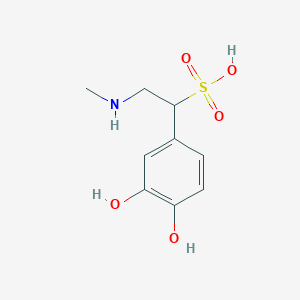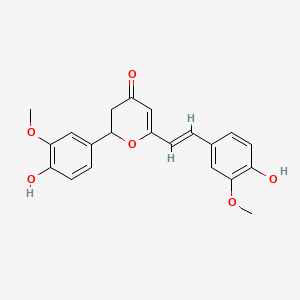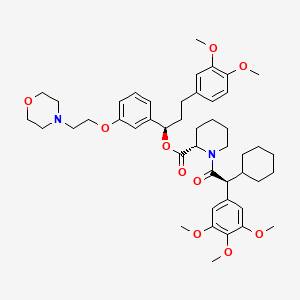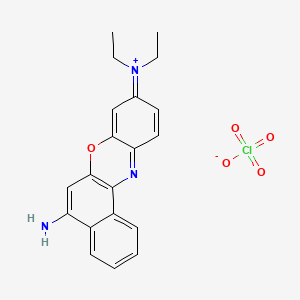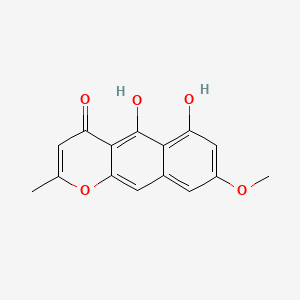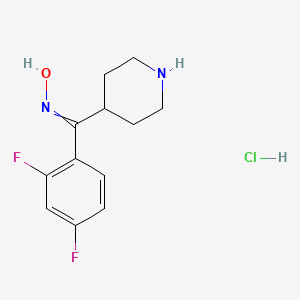
(2,4-Difluorophenyl)(piperidin-4-yl)methanone oxime hydrochloride
Overview
Description
(2,4-Difluorophenyl)(piperidin-4-yl)methanone oxime hydrochloride is a chemical compound with the molecular formula C12H15ClF2N2O and a molecular weight of 276.71 g/mol . This compound is known for its applications in the pharmaceutical industry, particularly as an intermediate in the synthesis of various drugs .
Mechanism of Action
Target of Action
It is known to be an intermediate in the synthesis of risperidone , which primarily targets dopamine D2 and serotonin 5-HT2 receptors in the brain.
Mode of Action
If it is indeed an intermediate in the synthesis of risperidone , it may contribute to the antipsychotic effects of the final product by interacting with dopamine and serotonin receptors.
Biochemical Pathways
As an intermediate in the synthesis of risperidone , it may indirectly influence the dopaminergic and serotonergic pathways in the brain.
Pharmacokinetics
As an intermediate in the synthesis of risperidone , its pharmacokinetic properties may be transformed during the synthesis process.
Result of Action
As an intermediate in the synthesis of risperidone , it may contribute to the antipsychotic effects of the final product.
Action Environment
It is recommended to store the compound under inert gas (nitrogen or argon) at 2-8°c .
Biochemical Analysis
Biochemical Properties
(2,4-Difluorophenyl)(piperidin-4-yl)methanone oxime hydrochloride plays a significant role in various biochemical reactions. It interacts with several enzymes, proteins, and other biomolecules. For instance, it has been observed to interact with cytochrome P450 enzymes, which are crucial for the metabolism of many drugs . The nature of these interactions often involves the inhibition or modulation of enzyme activity, which can affect the metabolic pathways of other compounds.
Cellular Effects
The effects of this compound on cellular processes are profound. It influences cell function by affecting cell signaling pathways, gene expression, and cellular metabolism. For example, it has been shown to modulate the activity of certain kinases involved in cell signaling, leading to altered gene expression patterns . This modulation can result in changes in cellular metabolism, affecting the overall function of the cell.
Molecular Mechanism
At the molecular level, this compound exerts its effects through specific binding interactions with biomolecules. It can inhibit or activate enzymes by binding to their active sites, leading to changes in their activity . Additionally, it can influence gene expression by interacting with transcription factors or other regulatory proteins, thereby altering the transcriptional activity of specific genes.
Temporal Effects in Laboratory Settings
In laboratory settings, the effects of this compound can change over time. The compound’s stability and degradation are critical factors that influence its long-term effects on cellular function. Studies have shown that it remains stable under specific storage conditions but may degrade over time, leading to reduced efficacy . Long-term exposure to the compound in in vitro or in vivo studies has revealed potential changes in cellular function, including alterations in metabolic activity and gene expression.
Dosage Effects in Animal Models
The effects of this compound vary with different dosages in animal models. At lower doses, the compound may exhibit beneficial effects, such as modulation of enzyme activity or gene expression . At higher doses, it can cause toxic or adverse effects, including cellular damage or disruption of normal metabolic processes. Threshold effects have been observed, indicating that there is a specific dosage range within which the compound is effective without causing harm.
Metabolic Pathways
This compound is involved in several metabolic pathways. It interacts with enzymes such as cytochrome P450, which play a crucial role in the metabolism of various compounds . These interactions can affect metabolic flux and alter the levels of specific metabolites, leading to changes in cellular metabolism.
Transport and Distribution
The transport and distribution of this compound within cells and tissues are mediated by specific transporters and binding proteins . These interactions influence the localization and accumulation of the compound, affecting its overall activity and function. The compound’s distribution can vary depending on the tissue type and the presence of specific transporters.
Subcellular Localization
This compound exhibits specific subcellular localization patterns. It may be directed to particular compartments or organelles within the cell through targeting signals or post-translational modifications . This localization can influence the compound’s activity and function, as it may interact with specific biomolecules within these compartments.
Preparation Methods
Synthetic Routes and Reaction Conditions
The synthesis of (2,4-Difluorophenyl)(piperidin-4-yl)methanone oxime hydrochloride typically involves the reaction of 2,4-difluorobenzaldehyde with piperidine in the presence of an oxime-forming reagent . The reaction is carried out under inert gas (nitrogen or argon) at temperatures ranging from 2-8°C . The product is then purified through crystallization to obtain the hydrochloride salt form .
Industrial Production Methods
Industrial production of this compound follows similar synthetic routes but on a larger scale. The process involves the use of automated reactors and purification systems to ensure high yield and purity . The reaction conditions are carefully controlled to maintain consistency and quality of the final product .
Chemical Reactions Analysis
Types of Reactions
(2,4-Difluorophenyl)(piperidin-4-yl)methanone oxime hydrochloride undergoes various chemical reactions, including:
Oxidation: This compound can be oxidized to form corresponding ketones or carboxylic acids.
Reduction: Reduction reactions can convert the oxime group to an amine.
Substitution: The compound can undergo nucleophilic substitution reactions, particularly at the fluorine atoms.
Common Reagents and Conditions
Oxidation: Common oxidizing agents include potassium permanganate (KMnO4) and chromium trioxide (CrO3).
Reduction: Reducing agents such as lithium aluminum hydride (LiAlH4) and sodium borohydride (NaBH4) are used.
Substitution: Nucleophiles like sodium methoxide (NaOMe) and potassium tert-butoxide (KOtBu) are commonly employed.
Major Products
Oxidation: Produces ketones or carboxylic acids.
Reduction: Forms amines.
Substitution: Results in various substituted derivatives depending on the nucleophile used.
Scientific Research Applications
Pharmaceutical Applications
-
Antipsychotic Activity :
- Research indicates that derivatives of the compound exhibit potential antipsychotic properties. The structural features of the piperidine ring are crucial for binding to dopamine receptors, which are implicated in psychotic disorders. Studies have shown that modifications in the fluorophenyl moiety can enhance receptor affinity and selectivity .
-
Neuroprotective Effects :
- There is emerging evidence suggesting that (2,4-Difluorophenyl)(piperidin-4-yl)methanone oxime hydrochloride may possess neuroprotective effects. In vitro studies have demonstrated its ability to inhibit neuronal apoptosis under oxidative stress conditions, making it a candidate for further investigation in neurodegenerative diseases .
-
Anti-Cancer Properties :
- Preliminary studies have indicated that this compound may exhibit anti-cancer activity through mechanisms such as apoptosis induction in cancer cells and inhibition of tumor growth in animal models. The piperidinyl component is believed to play a significant role in enhancing cytotoxicity against various cancer cell lines .
Analytical Applications
- Chemical Analysis :
- Biological Assays :
Case Studies
| Study | Focus | Findings |
|---|---|---|
| Study 1 | Antipsychotic Activity | Demonstrated effective binding to D2 dopamine receptors, indicating potential for treating schizophrenia. |
| Study 2 | Neuroprotection | Showed significant reduction in cell death under oxidative stress, suggesting therapeutic potential in Alzheimer's disease models. |
| Study 3 | Anti-Cancer Activity | Induced apoptosis in breast cancer cell lines, with IC50 values indicating promising anti-tumor efficacy. |
Comparison with Similar Compounds
Similar Compounds
- (4-Fluorophenyl)(piperidin-4-yl)methanone hydrochloride
- (2,4-Difluorophenyl)(piperidin-4-yl)methanone oxime
Uniqueness
(2,4-Difluorophenyl)(piperidin-4-yl)methanone oxime hydrochloride is unique due to its specific substitution pattern on the phenyl ring and the presence of the oxime group. This structural uniqueness contributes to its distinct chemical and biological properties, making it a valuable compound in pharmaceutical research and development .
Biological Activity
(2,4-Difluorophenyl)(piperidin-4-yl)methanone oxime hydrochloride, with the CAS number 135634-18-3, is a synthetic compound that has garnered attention for its potential biological activities. This compound belongs to a class of oximes and is characterized by its unique chemical structure, which includes a difluorophenyl group and a piperidine moiety. Understanding its biological activity is crucial for its potential application in pharmacology, particularly in the fields of neuropharmacology and oncology.
- Molecular Formula : C₁₂H₁₅ClF₂N₂O
- Molecular Weight : 276.71 g/mol
- Purity : Typically >95% in commercial preparations
- Storage Conditions : Recommended to be stored in an inert atmosphere at room temperature .
The biological activity of this compound is largely attributed to its interaction with various biological targets. Preliminary studies suggest that it may exhibit antipsychotic properties due to its structural similarity to known antipsychotic agents. The compound is believed to modulate neurotransmitter systems, particularly dopamine and serotonin pathways, which are critical in the treatment of psychiatric disorders.
Biological Activity Overview
Recent studies have investigated the biological activity of this compound across various assays:
- Antipsychotic Activity : In vitro assays indicated that this compound shows significant binding affinity for dopamine receptors, suggesting potential antipsychotic effects. This was demonstrated through receptor binding assays where the compound exhibited a notable inhibition of dopamine D2 receptor activity .
- Anticancer Potential : The compound has also been evaluated for its anticancer properties. In cell line studies, it demonstrated cytotoxic effects against various cancer cell lines, including breast and lung cancer cells. The mechanism appears to involve apoptosis induction and cell cycle arrest in the G2/M phase, as evidenced by flow cytometry analysis .
- Antimicrobial Activity : Preliminary antimicrobial assays revealed that the compound possesses moderate antibacterial properties against Gram-positive bacteria. Further investigations are needed to elucidate its full spectrum of antimicrobial activity .
Case Studies and Research Findings
Several studies have reported on the synthesis and biological evaluation of related compounds, providing insights into the structure-activity relationship (SAR) of oxime derivatives:
- A study by Umesha et al. highlighted that modifications in the piperidine ring can significantly enhance the potency of similar compounds against specific cancer cell lines .
- Another investigation focused on the synthesis of benzoyl-piperidin derivatives showed that introducing electron-withdrawing groups like fluorine can increase antitumor efficacy .
Data Table: Summary of Biological Activities
Properties
IUPAC Name |
(NE)-N-[(2,4-difluorophenyl)-piperidin-4-ylmethylidene]hydroxylamine;hydrochloride | |
|---|---|---|
| Source | PubChem | |
| URL | https://pubchem.ncbi.nlm.nih.gov | |
| Description | Data deposited in or computed by PubChem | |
InChI |
InChI=1S/C12H14F2N2O.ClH/c13-9-1-2-10(11(14)7-9)12(16-17)8-3-5-15-6-4-8;/h1-2,7-8,15,17H,3-6H2;1H/b16-12+; | |
| Source | PubChem | |
| URL | https://pubchem.ncbi.nlm.nih.gov | |
| Description | Data deposited in or computed by PubChem | |
InChI Key |
CPVWKXXFKMUDPA-CLNHMMGSSA-N | |
| Source | PubChem | |
| URL | https://pubchem.ncbi.nlm.nih.gov | |
| Description | Data deposited in or computed by PubChem | |
Canonical SMILES |
C1CNCCC1C(=NO)C2=C(C=C(C=C2)F)F.Cl | |
| Source | PubChem | |
| URL | https://pubchem.ncbi.nlm.nih.gov | |
| Description | Data deposited in or computed by PubChem | |
Isomeric SMILES |
C1CNCCC1/C(=N\O)/C2=C(C=C(C=C2)F)F.Cl | |
| Source | PubChem | |
| URL | https://pubchem.ncbi.nlm.nih.gov | |
| Description | Data deposited in or computed by PubChem | |
Molecular Formula |
C12H15ClF2N2O | |
| Source | PubChem | |
| URL | https://pubchem.ncbi.nlm.nih.gov | |
| Description | Data deposited in or computed by PubChem | |
Molecular Weight |
276.71 g/mol | |
| Source | PubChem | |
| URL | https://pubchem.ncbi.nlm.nih.gov | |
| Description | Data deposited in or computed by PubChem | |
CAS No. |
135634-18-3 | |
| Record name | Methanone, (2,4-difluorophenyl)-4-piperidinyl-, oxime, hydrochloride (1:1) | |
| Source | European Chemicals Agency (ECHA) | |
| URL | https://echa.europa.eu/substance-information/-/substanceinfo/100.113.612 | |
| Description | The European Chemicals Agency (ECHA) is an agency of the European Union which is the driving force among regulatory authorities in implementing the EU's groundbreaking chemicals legislation for the benefit of human health and the environment as well as for innovation and competitiveness. | |
| Explanation | Use of the information, documents and data from the ECHA website is subject to the terms and conditions of this Legal Notice, and subject to other binding limitations provided for under applicable law, the information, documents and data made available on the ECHA website may be reproduced, distributed and/or used, totally or in part, for non-commercial purposes provided that ECHA is acknowledged as the source: "Source: European Chemicals Agency, http://echa.europa.eu/". Such acknowledgement must be included in each copy of the material. ECHA permits and encourages organisations and individuals to create links to the ECHA website under the following cumulative conditions: Links can only be made to webpages that provide a link to the Legal Notice page. | |
Synthesis routes and methods
Procedure details






Disclaimer and Information on In-Vitro Research Products
Please be aware that all articles and product information presented on BenchChem are intended solely for informational purposes. The products available for purchase on BenchChem are specifically designed for in-vitro studies, which are conducted outside of living organisms. In-vitro studies, derived from the Latin term "in glass," involve experiments performed in controlled laboratory settings using cells or tissues. It is important to note that these products are not categorized as medicines or drugs, and they have not received approval from the FDA for the prevention, treatment, or cure of any medical condition, ailment, or disease. We must emphasize that any form of bodily introduction of these products into humans or animals is strictly prohibited by law. It is essential to adhere to these guidelines to ensure compliance with legal and ethical standards in research and experimentation.
